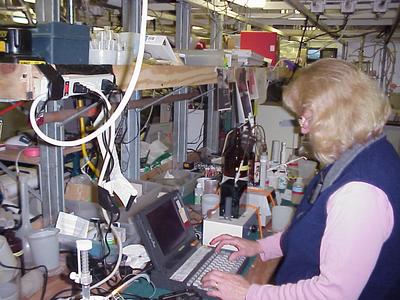
|
|
20 August, 2002
Today we finally had a bit of a break in our work. Since the storm, when
just about all the work that could be done was off the stern (including
benthic work), it seemed like we were doing benthic work around the clock.
The last four stations were done in less than 36 hours, and one or two of
those stations took nearly six hours to complete. It was tough to find time
to catch a little sleep, but Jackie allowed me to skip one station in order
to finish my journals. She, on the other hand, had not only the actual
station work, but also her own respiration experiments to run for the
samples from each station. Now that the Herald Valley stations are done, we
have one station left to do and it's several hours away. For the first time
in days, Jackie was able to get more than a couple of hours of sleep at a
time.
I've already told you about Jackie's work with the van Veen grabs and the
Haps core (see my journal from July 27). Let me tell you what happens
during her respiration experiments. Each time we do a Haps core, Jackie
chooses two of the best cores (clean cores with overlying water) and she
puts them into her cold room at -1 degree Celsius for her respiration
experiments. She replaces the overlying water with bottom water that she
collects from the CTD cast. She then measures start and end values of
bottom water oxygen content, pH and alkalinity (to determine total CO2), and
nutrients. She uses these values to get an indication of change over time
of these parameters during the experiment. She makes sure that all air
bubbles are out of her chambers and that they are sealed so no outside air
can get in. A small, battery-powered paddle at the top of the chamber
mimics the ocean currents at the bottom. When she leaves the chambers in
the dark for 12 - 24 hours, the organisms (animals, plants and even
bacteria) will respire (breath) naturally, and take up the oxygen in the
water. The driving factor behind the activity that takes place in the
chambers is the amount of carbon that is available. The usable carbon comes
from the plankton (phytoplankton and zooplankton), both living and dead,
found in the sediments. By measuring the oxygen uptake by the total
sediment community, Jackie can determine the carbon supply to the sediments.
It provides an indication of the areas where carbon deposition is more or
less abundant. Once the respiration experiments are complete, we sieve
these cores to find out what organisms were in them.
In addition to catching up on a bit of sleep today (we finished our last
Herald Valley station at 6 o'clock this morning), I parcticipated (with
Jackie, Lee, and the Captain) in a live audio presentation to the Burnham
library in my hometown of Colchester, VT. I don't think I had realized how
much I missed everyone until I heard all those familiar voices. Clearly the
cruise is winding down! We've been so busy previously that it's been
difficult to think of anything but work, journals and sleep. Now I have
started to think of how different it will be to be with people other than
the scientists and crew of the Healy, and how different it will be to see
something outside my window other than ocean and ice. There's no question
it will be an adjustment!
I want to be sure that you understand that there are times on board the ship
when people have a chance to relax and have a bit of fun. In addition to
the daily movies (at regular hours each night, but available by request
whenever you ask), there is a small gym on board, and lounge areas available
for the scientists, the officers, and the crew. Additionally, every
Saturday is morale day when a group other than the cooks prepares dinner and
other activities are scheduled in the evening. You might remember my
journal about our cooking efforts! Last Saturday we had pizza and ice cream
sundaes followed by a casino night. Members of the crew had made paper
money, with all our pictures on it. Luckily, pumping was scheduled (see
journal for July 23), and everyone had at least four hours to parcticipate.
Although most were tired and the pumping provided an opportunity to sleep,
nearly everyone joined in the fun of gambling with play money and bidding on
prizes at the end of the evening. It was a great way to relax and unwind a
bit!

<> Even Jackie and Lee took a little time off from their work to join in the fun of Casino Night!

<> Dr. Jackie Grebmeier runs respiration experiments on two of the cores from each Haps core sample.
Contact the TEA in the field at
.
If you cannot connect through your browser, copy the
TEA's e-mail address in the "To:" line of
your favorite e-mail package.
|
